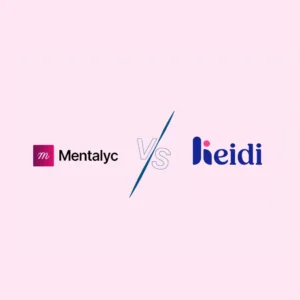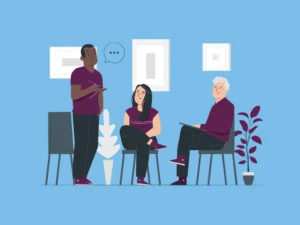Motivational Interviewing (MI) is fundamentally about working alongside clients as they dig into their own reasons for wanting change instead of telling them what they should do. We’ve all experienced those sessions where this becomes invaluable. Picture yourself sitting across from a client who expresses wanting something to change, yet somehow, every week feels like a rerun. Perhaps it’s the client who insists she’s ready to get sober yet lights up when describing her Friday night wine ritual with friends. Or consider the one who recognizes his relationship is slowly wearing him down but freezes when you ask him to imagine life on his own.
This is precisely where MI earns its place. Rather than positioning ourselves as the authority with all the solutions, MI asks us to get genuinely curious and work as partners. In the meantime, clients get to explore what change could actually look like for them. We’re not steering the ship, just helping them see what’s already beneath the surface. And when that clicks, even the most stagnant-feeling sessions can shift into something meaningful.
How to Use MI in Therapy: A Step-by-Step Implementation Guide
Mastering MI is about coming prepared but staying loose enough to follow wherever the conversation leads. Here’s how to weave MI into your therapeutic work:
Start with Session Structure and Preparation
Before the session begins:
- Review previous notes for change talk patterns and client values
- Set an intention to remain curious rather than directive
- Prepare to follow the client’s agenda, not yours
Opening each session:
- Start with expansive questions like: “What’s been sitting with you since we last talked?”
- Skip the urge to start fixing things immediately
- Allow silence and processing time
Apply the Four Core Processes Systematically
MI moves through four interconnected phases that flow into each other rather than following a strict order:
1. Engaging: Building genuine rapport where honest dialogue becomes possible.
Example: “I see you showing up here even when everything feels like too much.”
2. Focusing: Narrowing in on what matters most to your client (not your agenda).
You could ask: “You’ve brought up stress at work, what’s happening in your relationship, and worries about drinking. Which of these is weighing on you most heavily right now?”
3. Evoking: Drawing out motivations, values, and reasons for change.
This sounds like: “What would be different in your life if this problem wasn’t weighing on you anymore? What would that give you?”
4. Planning: Creating concrete, realistic implementation strategies.
This might sound like: “You’ve said you want to drink less. What’s one tiny thing you could try this week that feels manageable?”
You’ll find yourself moving between focusing and evoking or circling back to building connection when that feels necessary. Trust the process.
Master Strategic Communication
The foundation of MI lies in four core communication skills, but during implementation, focus on:
- Asking questions that invite exploration rather than yes/no responses
- Reflecting on what you hear both in content and emotion
- Recognizing strengths and efforts authentically
- Summarizing strategically to highlight change talk
Recognize and Respond to Client Language
Listen for the difference between Change Talk (desire, ability, reasons, need, commitment) and Sustain Talk (reasons to maintain the status quo). When you hear change talk, reflect it with emphasis and ask for elaboration. When you hear sustain talk, reflect it and shift focus back to exploring motivation.
Why Isn’t Technique Enough in Motivational Interviewing?
It took me years to understand this: You can memorize every MI technique and completely miss the point. The “spirit” of MI isn’t a fluffy therapeutic philosophy; it distinguishes genuine collaboration from nicer-sounding manipulative methods.
- Partnership sounds simple until you realize how often we slip into expert mode. I’ve caught myself explaining to clients why their coping strategy wasn’t working instead of asking what they noticed about their strategy. The shift from “working on” to “working with” is subtle but revolutionary.
- Acceptance goes beyond unconditional positive regard. Miller and Rollnick call it “absolute worth,” and honestly, this can initially feel overwhelming. How do you stay accepting when your client makes decisions that concern you? It comes down to distinguishing who they are and what they’re doing, though that’s much harder.
- Compassion drives your interactions. Caring for your client’s well-being is real, not just about completing treatment requirements or following procedures.
- Evocation is the most radical shift. Instead of installing motivation, you’re drawing out what’s already there. Clients come to us with the capacity for positive change; your job is to help them find it, name it, and build on it.
OARS: The Foundation Skills That Work
OARS stands for Open-Ended Questions, Affirmations, Reflective Listening, and Summaries, the four core communication skills that form MI’s foundation. OARS transforms from a set of techniques into a natural cadence of authentic interest in your client’s experience. Consider them your navigation system when you feel lost in session, not items to check off.
Open-Ended Questions: Beyond the Surface
These types of questions allow the clients to go much deeper into their thinking rather than being trapped in short and dead-end answers. The important thing here is that the client should be interacted with just like you would a friend with sincere interest, not as if you are checking off a list.
Instead of: “Are you ready to quit smoking?”
Try: “What would need to shift for you to feel ready to address your smoking?”
Instead of: “Do you think your drinking is a problem?”
Try: “What concerns you most about your current drinking pattern?”
The difference? The second version assumes your client is the expert on their own experience.
Affirmations: Noticing Strengths with Intention
When you get affirmations right, they highlight something real and meaningful about your client’s efforts, growth, or values. They’re not vague cheerleading; they’re specific observations about what you actually see happening.
Avoid affirmations that feel vague or evaluative, such as:
- “Good job.”
- “You’re so smart for coming to therapy.”
Instead, try something more meaningful:
- “You’ve shown a lot of persistence in working through this.”
- “It sounds like you’re really committed to making this change.”
Reflective Listening: The Eye-Opener
This is where MI becomes powerful. You reflect not just what clients say but what’s beneath the words.
Simple reflection:
Client: “I’m just so tired of feeling this way.”
Therapist: “You’re exhausted by these feelings.”
Complex reflection:
Client: “I don’t know why I even bother trying.”
Therapist: “Some part of you questions whether it’s even worth it, but here you are, still putting one foot in front of the other.”
That “but here you are” is powerful; it honors their struggle and persistence.
Summaries: Strategic Listening
Summaries aren’t just recap sessions. They demonstrate deep listening while strategically emphasizing change talk and de-emphasizing sustain talk. They’re perfect for shifting between topics or pointing out themes your client hasn’t noticed yet.
Advanced Techniques That Make a Difference
The Readiness Ruler: Simple but Powerful
Try something like: “On a scale from 1 to 10, how ready do you feel to make this change?” Then dig in: “What puts you at a [their number] instead of a 1?” That question alone shows them there’s already something motivating them, even if they’re only at a 2 or 3. And from there, ask: “What would help bump that number a little higher?”
Rolling with Resistance: When Clients Push Back
When you encounter resistance, avoid that immediate impulse to start problem-solving or making your case. Instead:
- Reflect on the resistance: “You’re feeling pressured by everyone around you to make changes you’re not sure you want.”
- Emphasize choice: “What you decide about this is entirely up to you.”
- Get curious: “What about changing feels most concerning right now?”
Developing Discrepancy: The Values Connection
Help your clients explore gaps between current behavior and their stated values, but do this gently:
- “You’ve mentioned being a good parent is crucial to you. How does your current drinking fit with that value?”
This isn’t about creating shame but highlighting inconsistencies that might naturally motivate change.
Pros and Cons Exploration
Work with your client to create a written Pros and Cons list either right there in the session or by going through one they’ve already filled out. This approach lets clients methodically examine both sides of their internal conflict.
Implementation steps:
- Invite the client to explore both sides: “What are some benefits you get from [current behavior]?”
- Then explore costs: “What concerns you about continuing this pattern?”
- Reflect the complexity rather than pushing toward one side
Recognizing Change Talk vs. Sustain Talk
Knowing the difference between these two is essential for how you respond.
Change Talk includes:
- Desire: “I want to,” “I wish.”
- Ability: “I can,” “I might be able to.”
- Reasons: “I think quitting would help me be more present with my kids.”
- Need: “I really need to get a handle on this.”
- Commitment: “I’m planning to cut back this week.”
These statements typically signal a shift; the client is starting to envision life on the other side of change.
These statements usually mark a shift; they show that the client is already picturing life after making the change.
When Change Talk surfaces: Mirror it back with energy, invite them to expand on it, and pull together what you’re picking up.
Sustain Talk sounds like:
- “I don’t understand why I need to change.”
- “This isn’t actually a problem.”
- “I’ve attempted this before, and it didn’t work.”
When you hear Sustain Talk: Reflect it simply without emphasis, then shift focus back to change talk. Don’t argue or challenge directly.
MI Across Different Clinical Contexts
Substance Use: Where MI Began
MI recognizes that ambivalence isn’t resistance; it’s part of the process.
Client: “Everyone says I drink too much, but I don’t see it as a big deal. I function fine at work.”
MI Response: “So people close to you are concerned, and from your perspective, it’s not interfering with your work performance. Tell me more about what drinking does for you.”
Anxiety and Depression: When Clients Feel Stuck
MI validates internal conflicts around treatment engagement.
Client: “I know I should do the homework, but I just can’t make myself do it.”
MI Response: “Part of you recognizes the value in these exercises, and another part struggles to follow through. What gets in the way when you think about doing them?”
Health Behavior Change: Beyond Doctor’s Orders
Client: “My doctor says I need to lose weight, but every time I try, I fail.”
MI Response: “Past attempts haven’t worked out how you hoped, and yet your doctor is still recommending weight loss. What feels different about this conversation now?”
Common Pitfalls (And How to Avoid Them)
The Question-Answer Trap
The problem: Rapid-fire questions without sufficient reflection.
The solution: For every question, offer two reflections. This forces you to slow down and truly listen.
Premature Focus
The problem: Jumping to planning before exploring motivation.
The solution: Get comfortable sitting with ambivalence. Clients who aren’t talking about change are not ready for planning.
The Righting Reflex
The problem: Feeling compelled to fix or convince immediately.
The solution: Remember, your job is evoking your clients’ motivations, not imposing yours.
Cultural Considerations: Supporting Collective Values
Western therapy tends to focus heavily on individual choice and personal autonomy. But that doesn’t resonate with everyone who walks through your door. Many clients naturally think about decisions regarding how they’ll affect their family, what their community expects, or what aligns with their cultural values, not just what they want as individuals.
To help such clients better, you could try to reach out to them like this:
- “What would your family say if you chose it this way?”
- “Have there been any cultural or community values crossing your mind here that are important to you?”
These questions greatly help allow clients to truly represent their whole selves in the therapeutic space.
Integration with Other Approaches
MI integrates smoothly as the foundation for other evidence-based treatments:
- With CBT: Use MI to explore ambivalence about changing thought patterns before introducing cognitive restructuring
- With DBT: Help clients explore their relationship with emotional regulation skills and motivation to practice them
- With trauma work: MI supports autonomy and safety, aligning perfectly with trauma-informed principles
Signs MI Is Working (And When It’s Not)
Positive indicators:
- More change talk from clients
- Clients developing their own solutions
- Increased curiosity and engagement
Warning signs:
- Increased sustain talk
- Clients becoming argumentative
- You’re working harder than your client
Side note: If you’ve ever felt like you’re working harder than your client, you’re probably right, and that’s a red flag worth exploring.
Building Your MI Skills: Beyond the Basics
Check In With Yourself
Every so often, it’s worth asking:
- Am I coming in with real curiosity about where my client is coming from?
- Am I listening more than talking?
- How does it feel to sit with my client’s ambivalence?
- Am I letting go of the need to fix things, or am I jumping in too fast?
Practice Exercises
- Daily reflection practice: Spend 10 minutes practicing reflective listening with friends or colleagues
- Change talk tracking: During sessions, notice patterns in change vs. sustain talk
- Video review: Record sessions (with consent) and review for MI adherence
Making MI Part of Your Clinical Identity
As you dive deeper into MI, remember that your presence matters as much as your words. When you truly embrace collaboration, those stuck sessions can become rich conversations that actually spark real change. MI changes how you show up, not just what you say. Once you start genuinely trusting your clients’ wisdom, you can no longer be the expert with all the answers. What makes MI so effective is that it taps into something fundamental about how people work: we’re much more likely to stick with changes we decide on ourselves rather than ones forced on us. Often, the most impactful thing you can do is help someone uncover what they already understand deep down.
What is the irony of doing great MI work? The richer your sessions become, the more complex your documentation gets. Between tracking change talk, sustain talk, and those subtle shifts in client motivation, notes can take forever. How do you capture the nuance of a client’s ambivalence in standard treatment note format? That’s where having the proper documentation support makes all the difference. Tools like Mentalyc understand the complexity of therapeutic work and can help you spend less time wrestling with notes and more time focused on the actual clinical work.
FAQ About Motivational Interviewing
What sets motivational interviewing apart from other therapies?
Most therapeutic approaches position us as experts: We evaluate, diagnose, and create treatment plans. MI flips that script. You’re not the captain giving directions; you’re more like a co-navigator. Instead of jumping in with solutions, you get curious. You ask questions that help clients sort through the noise and reconnect with what matters to them. That shift from pressure to partnership is what makes MI work.
How does motivational interviewing work with addiction?
Feeling torn about addiction is completely normal—it’s not something to overcome; it’s actually where the real work happens. MI creates space for clients to explore both sides of their inner struggles without judgment or pressure. When clients voice their own reasons for change, those words carry much more weight than anything we could say to them.
Does motivational interviewing work alongside other therapy approaches?
It often works best that way. Consider MI like laying the foundation or setting the stage. It helps clients clarify why they might want to engage in CBT or DBT. MI pairs beautifully with trauma-informed approaches since both prioritize safety, personal choice, and giving clients their voices back.
What mistakes do therapists often make when learning MI?
One big one is rushing to plan before the client’s actually ready. Another is falling into the “fix-it” reflex, offering solutions instead of evoking motivation. While reflections are powerful, flooding clients with them without direction can leave them feeling lost or passive. Always refer back to partnership, compassion, and curiosity.
References:
Cherry, K. (2023). What is motivational interviewing? Verywell Mind.
Climb and PCC Community. (2023). Who benefits from motivational interviewing training. Portland Community College.
Lean Blog Audio: Understanding slow decisions: How motivational interviewing can help at work. Lean Communicators. (2024). Lean Communicators.
Motivational interviewing: A treatment technique. (n.d.). Hazelden Betty Ford Foundation.
Motivational interviewing FAQ. (n.d.). Psychwire.
Motivational interviewing pocket guide [PDF]. (2016). Building Better Programs.
Motivational interviewing questions to ask [PDF].
Polizzi, K. (2022). What is motivational interviewing? Psychology Today.
PositivePsychology.com. (2021). Motivational interviewing effectiveness.
PositivePsychology.com. (2021). Motivational interviewing principles.
Poznyak, O. (n.d.). Motivational interviewing pocket guide [PDF]. Hazelden Betty Ford Foundation.
Rollnick, S., & Miller, W. R. (Eds.). (2020). MI components & spirit of motivational interviewing. University of North Carolina CFAR.
Rollnick, S., & Miller, W. R. (Eds.). (2020). Motivational interviewing in… In Motivational interviewing. National Center for Biotechnology Information.
Rothman, A. R. (n.d.). Motivational interviewing: Understanding motivational interviewing. Miller–Rollnick Institute.
Siegel, J., & Motrica, B. (n.d.). Motivational counseling: A guide. McGill University.
Smith, J. (n.d.). Motivational interviewing definition, principles, and approach. UMass Amherst Student Life.
Teixeira, P. J., Carraça, E. V., Markland, D., Silva, M. N., & Ryan, R. M. (2012). Exercise, physical activity, and self-determination theory: A systematic review. International Journal of Behavioral Nutrition and Physical Activity, 9, 78.
Velasquez, M. M. (2011). Comparison of motivational interviewing studies [Abstract]. Journal of Substance Abuse Treatment, 39(2), 127–134.
Wisdome, R. (n.d.). Motivational interviewing [PDF]. Brown University Lifespan Center.
Yule, K., Arbour-Nicitopoulos, K. P., Martin Ginis, K. A., Latimer-Cheung, A. E., & Tomasone, J. R. (2023). Testing mechanisms of motivational interviewing on physical activity and related psychosocial outcomes among adults with physical disabilities: A randomized controlled trial. Psychological Reports, 126(2), 828–857.
Why other mental health professionals love Mentalyc

“For those who have hesitations … It is a lifesaver. It will change your life and you have more time to be present with your patients.”
Licensed Clinical Social Worker

“It immediately changed my quality of life, personally and professionally. I went from 3–4 hours a week of notes to 1 hour at most … that alone is invaluable personally and professionally.”
Owner/Independently Licensed Marriage & Family Therapist (IMFT)

“If I were recommending this software to a colleague, I would tell them that it is the best thing that they could do for their practice.”
Licensed Professional Counselor

“Do yourself a favor, make your life easier. Use the tools that are readily available … I found Mentalyc to be one of the best tools that I’ve ever used.”
Licensed Marriage and Family Therapist






